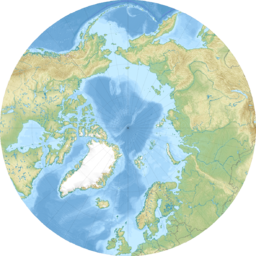| Prince Gustaf Adolf Sea | |
|---|---|
 Location | |
| Location | Arctic Ocean |
| Coordinates | 78°30′30″N 106°45′40″W / 78.50833°N 106.76111°W |
| Type | Sea |
| Basin countries | Nunavut and Northwest Territories, Canada |
| Max. length | 800 km (500 mi) |
Prince Gustaf Adolf Sea formerly Prince Gustav Adolf Sea[1] (French: Mer du Prince-Gustave-Adolphe) is a marginal sea of the Arctic Ocean located in the Qikiqtaaluk Region, Nunavut,[2] and the Inuvik Region,[3] Canada.
Geography[edit]
It is situated among the islands of the Arctic Archipelago. The sea is bounded on the west by Borden Island and Mackenzie King Island, and on the east by Ellef Ringnes Island. To the south is Lougheed Island. The sea opens into the Arctic Ocean to the north, and into the Byam Martin Channel and Maclean Strait to the south.
The Sea was named in 1898 by Otto Sverdrup after the Swedish prince (and later king) Gustav VI Adolf.[4][5]
See also[edit]
References[edit]
- ^ Prince Gustaf Adolf Sea / Prince Gustaf Adolf Sea (Formerly Prince Gustav Adolf Sea)
- ^ Prince Gustaf Adolf Sea, Nunavut
- ^ Prince Gustaf Adolf Sea, Northwest Territories
- ^ Otto Neumann, Sverdrup (1959). Arctic adventures: Adapted from New land: four years in the Arctic regions. Longmans. p. 215.
- ^ Barr, Elinor (2015-07-27). Swedes in Canada: Invisible Immigrants. University of Toronto Press. ISBN 9781442695153.

Well, that’s interesting to know that Psilotum nudum are known as whisk ferns. Psilotum nudum is the commoner species of the two. While the P. flaccidum is a rare species and is found in the tropical islands. Both the species are usually epiphytic in habit and grow upon tree ferns. These species may also be terrestrial and grow in humus or in the crevices of the rocks.
View the detailed Guide of Psilotum nudum: Detailed Study Of Psilotum Nudum (Whisk Fern), Classification, Anatomy, Reproduction